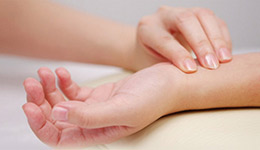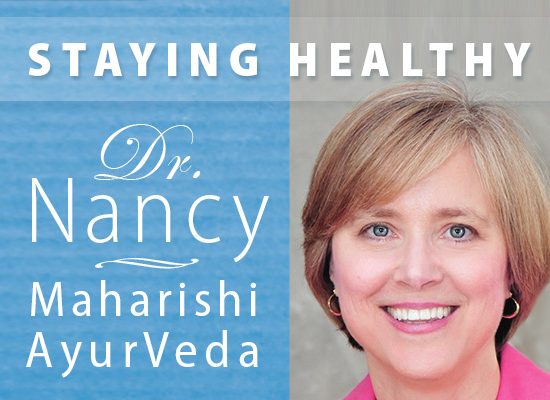Best-selling author Dr. Nancy Lonsdorf M.D. has been an Ayurvedic practitioner for more than 30 years and is recognized as one of the nation’s most prominent Ayurvedic doctors. She teaches Maharishi AyurVeda® in affiliation with the Academy of Integrative Health and Medicine and the University of Maryland School of Medicine’s Center for Integrative Medicine. A frequent speaker on national media, she continues her private practice in integrative medicine and Ayurveda, including Wellness Consultations in person or by phone. She discusses the topics of this article in this video ►
Have you ever noticed how taking care of your health is a multi-doctor affair?
We have one doctor to treat our stomach, another to fix our back, and yet another to quell our worry and help us sleep at night. Yet none of the doctors seem to know what the others are doing, and no one is looking at us—mind, body, and spirit—as a whole.
Welcome to the fragmented approach of Western medicine. Western or “allopathic” medicine focuses on treating the various parts of the body that already have symptoms of disease, rather than striving to create balance and true healing from a deeper, more holistic level.
Uniquely, Maharishi AyurVeda is “consciousness-based” Ayurveda: it integrates the knowledge and technologies of consciousness, such as TM®, to support the healing of mind, body, and spirit.
Take Jessica (not her real name), a 38-year-old woman who came to see me due to insomnia, anxiety, constipation, and heart palpitations. Although her doctors had assured her there was nothing seriously wrong, drugs were all they had to offer, so she was prescribed medication for each of her complaints. Now Jessica was looking for a more holistic approach, one that would allow her to get off the medications and be healthy, naturally.
The Modern Revival of Ayurveda—Maharishi AyurVeda
Fortunately, a holistic, “back-to-the-future” style of knowledge called Ayurveda has arrived, direct from the ancient Vedic civilization of India, circa 5,000 years ago. Ayurveda is a comprehensive system of natural health care that looks at the basic causes of disease, rather than just treating symptoms on the surface.
The modern revival of Ayurveda, called Maharishi AyurVeda (MAV), is the complete restoration of Ayurveda according to the original, authentic texts by leading Ayurvedic physicians and scholars under the inspiration and guidance of Maharishi Mahesh Yogi, Founder of the Transcendental Meditation® (TM) program.

Uniquely, Maharishi AyurVeda is “consciousness-based” Ayurveda: it integrates the knowledge and technologies of consciousness, such as Transcendental Meditation, to support the healing of mind, body, and spirit.
From the perspective of Western medicine, each tissue, organ, and system is viewed separately from all the others, with a different doctor for each system—the GI doctor for our irritable bowel, the cardiologist for our heart, and so on. In contrast, Ayurveda looks at what is common to all the systems and treats their common source.
Specifically, Ayurveda identifies three supersystems that include the functions of all the tissues, organs, and systems of the body. Ayurveda understands disease as resulting from imbalanced functioning in one or more of these three supersystems, which govern the three fundamental functions of all our cells and tissues: movement and flow, metabolism, and physical structure. I also explain these supersystems in this video ►
Ayurveda identifies three supersystems that include the functions of all the tissues, organs, and systems of the body. Ayurveda understands disease as resulting from imbalanced functioning in one or more of these three.
What Happened with Jessica?
After doing a thorough review of Jessica’s health history, medical testing, and prior doctor reports to ensure that her conditions were safe to treat in full naturally, without allopathic medications, I put on my Ayurveda hat and explained to her the following:

Pulse diagnosis is a key element of an Ayurvedic health evaluation
“Fortunately, natural approaches should be enough to heal your issues. According to Ayurveda, your symptoms are due to an imbalance in how your body is functioning, rather than a disease that needs medication.
“And instead of looking at your symptoms as four separate problems, Ayurveda tells us that all four symptoms are actually due to just one underlying imbalance in a category of function called vata.
“By balancing your vata functions of movement, circulation, and flow, we can help all your symptoms at once. And the best part is that we can probably accomplish this with simple lifestyle changes, diet, and perhaps some herbal supplement support.”
Needless to say, Jessica was very happy to hear this news. She would be able to address her symptoms in a natural, holistic way, just as she’d hoped.
The Supersystems Guiding Our Health
The three supersystems, called doshas, inform Ayurvedic doctors, and Western doctors trained in this approach, as to what kind of diet, daily routine, and supplements may help a person “turn the corner” on their illness and reduce or get off meds, by improving their lifestyle.
The three doshas in Ayurveda are called vata, pitta, and kapha. You can think of them as guiding physiological principles that keep all of your bodily functions balanced and healthy.
Each dosha is present throughout your physiology, governing all the activities of your body, mind, and emotions. They are both your body’s “Generals” and “shock troops,” because they guide and mediate the body’s normal daily functions as well as adaptive responses to environmental stressors of all kinds—climatic, dietary, physical, mental, and emotional.
Here is the key point: The fundamental approach of Maharishi AyurVeda is to restore and maintain balance within each of the three doshas, since they are the main determinants of our health.
The fundamental approach of Maharishi AyurVeda is to restore and maintain balance within each of the three doshas, since they are the main determinants of our health.
The Three Doshas: Vata, Pitta, and Kapha
Here’s a brief introduction to each of the three supersystems or doshas guiding your health, and what each is in charge of in your body.

Ayurveda offers dietary suggestions for balancing the doshas
Vata governs movement and coordination between all of the hundred trillion cells in the body. Thus vata governs circulation, the nervous system, and basically everything in the body that has to do with movement.
Pitta has to do with energy production. All of the metabolism and digestion that gives us the energy to move and function falls under the category of pitta.
Kapha has to do with physical structure. The physical body—its structure, material, muscle, bones, fluids, and skin—in other words, everything that’s material about the body falls under the category of kapha.
Upcoming Tips
Next month, learn more about how to balance your three doshas—vata, pitta, and kapha. I’ll explain the characteristics that go along with each, as well as the symptoms that may result from their imbalance. Most importantly, I’ll give you tips on what you can do to banish such symptoms from your life in order to feel and look your best.
To learn more about doshas, watch this video with Dr. Lonsdorf ►
For more information on Dr. Lonsdorf’s practice, visit www.drlonsdorf.com. To schedule an Ayurvedic Wellness Consultation by phone or teleconference, please contact Dr. Lonsdorf’s office at 641-469-3174 or healthoffice@drlonsdorf.com.
Copyright 2017, Nancy K. Lonsdorf, M.D. All rights reserved. Do not reproduce without written permission of the author.







Hello Nancy, you do not look any different then when i first met you in 1986 in India when you were staying at Mrs. Sharma’s house.
Thanks, George, for the kind words and the wonderful memories. Whatever credit there is goes to the healing and rejuvenating knowledge of Maharishi AyurVeda in our lives.
Happy, healthy, New Year to all!
Thank you, Raou, for your comments appreciating the difference between the wholistic and fragmented approaches, and the added healing power of attending to the underlying intelligence that is running the body and keeping it healthy in the first place. I hope you will find the upcoming tips useful for your own health and wholeness!
This really simplifies the difference between the fragmented approach and a holistic approach. I really like the scientific approach used describe underlying governing principles, we have been raised to understand that everything is emerging from the causal level, these ayurvedic principles show much more potential to cure health problems. Looking forward to the next article continuing this discussion.